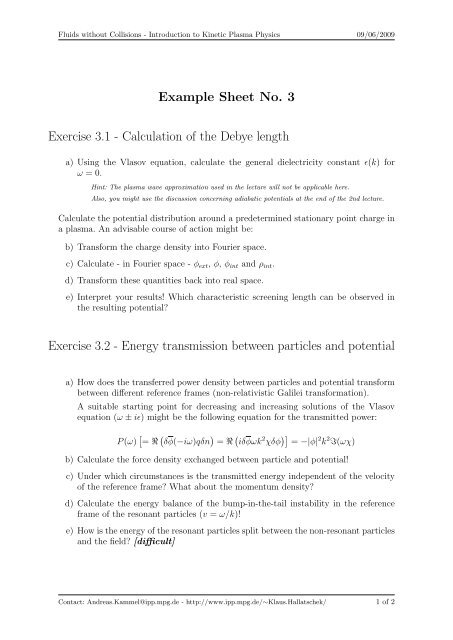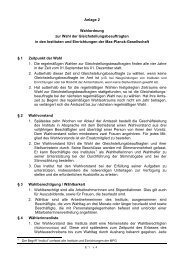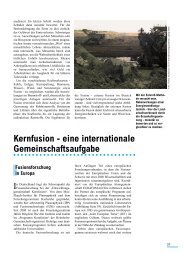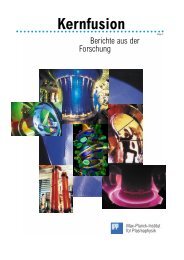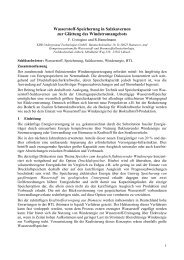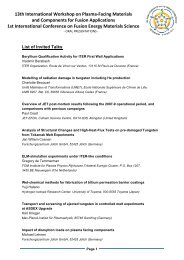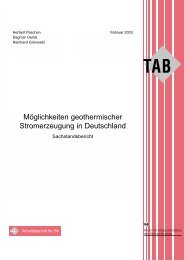Example Sheet No. 3 Exercise 3.1 - Calculation of the Debye length ...
Example Sheet No. 3 Exercise 3.1 - Calculation of the Debye length ...
Example Sheet No. 3 Exercise 3.1 - Calculation of the Debye length ...
Create successful ePaper yourself
Turn your PDF publications into a flip-book with our unique Google optimized e-Paper software.
Fluids without Collisions - Introduction to Kinetic Plasma Physics 09/06/2009<br />
<strong>Example</strong> <strong>Sheet</strong> <strong>No</strong>. 3<br />
<strong>Exercise</strong> <strong>3.1</strong> - <strong>Calculation</strong> <strong>of</strong> <strong>the</strong> <strong>Debye</strong> <strong>length</strong><br />
a) Using <strong>the</strong> Vlasov equation, calculate <strong>the</strong> general dielectricity constant ɛ(k) for<br />
ω = 0.<br />
Hint: The plasma wave approximation used in <strong>the</strong> lecture will not be applicable here.<br />
Also, you might use <strong>the</strong> discussion concerning adiabatic potentials at <strong>the</strong> end <strong>of</strong> <strong>the</strong> 2nd lecture.<br />
Calculate <strong>the</strong> potential distribution around a predetermined stationary point charge in<br />
a plasma. An advisable course <strong>of</strong> action might be:<br />
b) Transform <strong>the</strong> charge density into Fourier space.<br />
c) Calculate - in Fourier space - φext, φ, φint and ρint.<br />
d) Transform <strong>the</strong>se quantities back into real space.<br />
e) Interpret your results! Which characteristic screening <strong>length</strong> can be observed in<br />
<strong>the</strong> resulting potential?<br />
<strong>Exercise</strong> 3.2 - Energy transmission between particles and potential<br />
a) How does <strong>the</strong> transferred power density between particles and potential transform<br />
between different reference frames (non-relativistic Galilei transformation).<br />
A suitable starting point for decreasing and increasing solutions <strong>of</strong> <strong>the</strong> Vlasov<br />
equation (ω ± iɛ) might be <strong>the</strong> following equation for <strong>the</strong> transmitted power:<br />
P (ω) � = ℜ � δφ(−iω)qδn � = ℜ � iδφωk 2 χδφ �� = −|φ| 2 k 2 ℑ(ωχ)<br />
b) Calculate <strong>the</strong> force density exchanged between particle and potential!<br />
c) Under which circumstances is <strong>the</strong> transmitted energy independent <strong>of</strong> <strong>the</strong> velocity<br />
<strong>of</strong> <strong>the</strong> reference frame? What about <strong>the</strong> momentum density?<br />
d) Calculate <strong>the</strong> energy balance <strong>of</strong> <strong>the</strong> bump-in-<strong>the</strong>-tail instability in <strong>the</strong> reference<br />
frame <strong>of</strong> <strong>the</strong> resonant particles (v = ω/k)!<br />
e) How is <strong>the</strong> energy <strong>of</strong> <strong>the</strong> resonant particles split between <strong>the</strong> non-resonant particles<br />
and <strong>the</strong> field? [difficult]<br />
Contact: Andreas.Kammel@ipp.mpg.de - http://www.ipp.mpg.de/∼Klaus.Hallatschek/ 1 <strong>of</strong> 2
Fluids without Collisions - Introduction to Kinetic Plasma Physics 09/06/2009<br />
<strong>Exercise</strong> 3.3 - BGK modes<br />
Construct <strong>the</strong> BGK solutions <strong>of</strong> <strong>the</strong> Vlasov equation for <strong>the</strong> following electrical potentials<br />
(as usual, you may assume a fusion plasma, thus T ≫ qφ)<br />
Recommended course <strong>of</strong> action:<br />
a) φ/φ0 =<br />
�<br />
x<br />
�2 − 1 for |x| ≤ l<br />
l<br />
(0 o<strong>the</strong>rwise)<br />
b)<br />
c)<br />
φ/φ0 =<br />
φ/φ0 =<br />
sin(kx) − 1<br />
�<br />
− exp − x2<br />
2σ2 �<br />
• Utilize <strong>the</strong> following ansatz for <strong>the</strong> distribution function: ftotal(v) = f0(ɛ + qφ) +<br />
f(ɛ + qφ) where f(ɛ + qφ) = 0 for ɛ + qφ > 0 and f0 marks <strong>the</strong> Maxwellian<br />
distribution.<br />
Hint: Use constant phase space density for <strong>the</strong> trapped particles<br />
• Use this to construct <strong>the</strong> equation for <strong>the</strong> particle density.<br />
• Carry out <strong>the</strong> transformation from v to z ≡ ɛ + qφ.<br />
• Use � b<br />
a<br />
1<br />
√ b−z<br />
√ 1 dx = π for <strong>the</strong> calculation <strong>of</strong> <strong>the</strong> particle density - you should now<br />
z−a<br />
be able to solve <strong>the</strong> particle density for <strong>the</strong> perturbed distribution function f.<br />
Hint: You might have to expand <strong>the</strong> term <strong>of</strong> <strong>the</strong> particle density by an appropriate integral<br />
• Thus, calculate f(φ) for <strong>the</strong> different φ given.<br />
Contact: Andreas.Kammel@ipp.mpg.de - http://www.ipp.mpg.de/∼Klaus.Hallatschek/ 2 <strong>of</strong> 2


